As a new parent, I’ve learned that giving my little one the best nutrition is key. Making my own baby food lets me control the ingredients. This ensures my baby gets the highest-quality, most nutritious foods. Plus, it’s cost-effective and rewarding.
In this guide, I’ll share my knowledge on making easy and tasty baby recipes. These recipes are full of essential vitamins, minerals, and nutrients. Whether you’re starting with solid foods or your baby is more experienced, you’ll find helpful tips here. You’ll learn about kitchen equipment, food safety, and how to mix flavors for different ages.
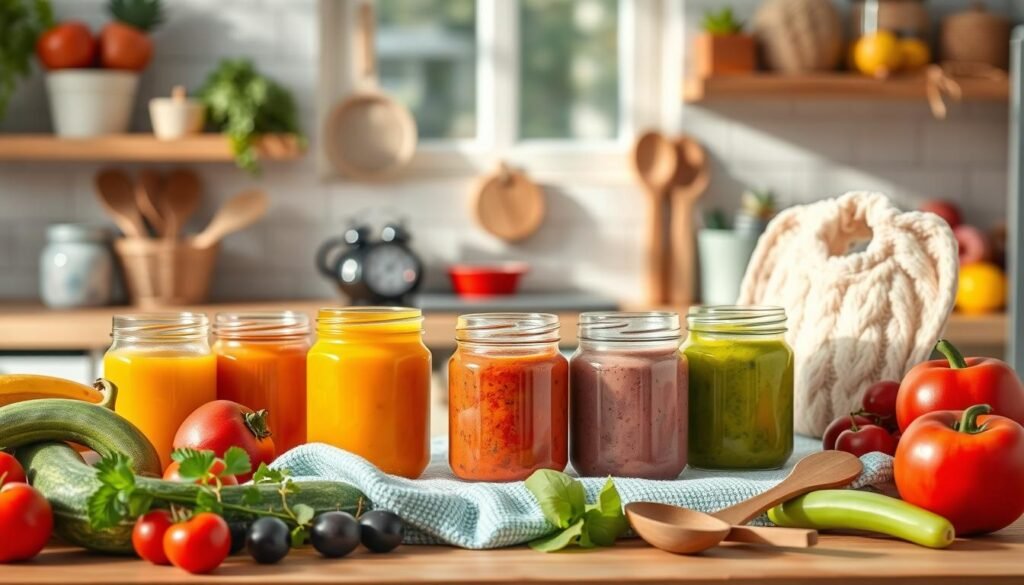
Key Takeaways
- Homemade baby food gives you control over ingredients, ensuring top nutrition for your baby.
- Making your own baby food is a budget-friendly choice compared to store-bought options.
- This guide covers essential equipment, safety tips, nutrient-rich first foods, and creative recipe ideas for different ages.
- Discover the benefits of homemade baby food and learn how to prepare easy, delicious, and nutritious meals for your growing child.
- Explore a wide range of baby-friendly recipes, from simple fruit and vegetable purees to adventurous flavor combinations.
Getting Started with Homemade Baby Food Basics
Making your own baby food might seem hard at first. But with the right tools and knowledge, it’s very rewarding. It’s a great way to give your baby nutritious meals. Let’s look at the basic equipment, safety tips, and the different stages of baby food.
Essential Kitchen Equipment for Baby Food Preparation
Having the right tools is key for making baby food. You’ll need a good blender or food processor, steam baskets, storage containers, and ice cube trays. These tools will help you puree, steam, and store your baby’s food easily.
Safety Guidelines and Storage Tips
- Make sure all utensils and surfaces are clean and sanitized before use.
- Put prepared baby food in the fridge or freezer within 2 hours to keep it fresh.
- Label and date all containers so you know when the food was made.
- Talk to your pediatrician about how long to store food and the best temperatures.
Understanding Baby Food Stages
As your baby grows, their food needs and likes change. Start with smooth, thin purees. Then, move to thicker, chunkier foods as they learn to chew and swallow. By 12 months, they’ll be ready for a variety of table and finger foods.
With the right tools, safety tips, and knowledge of baby food stages, you’re ready to make delicious meals for your baby. The journey of baby food preparation is rewarding. It lets you nourish your child and bond over infant food and baby feeding guide.
Why Making Your Own Baby Food Matters
As a new parent, I’ve learned the big benefits of making my own baby food. It saves money and lets me control what my baby eats. This means I can pick the best ingredients and flavors for them.
Homemade baby food is packed with nutrients. I use fresh, whole foods to make sure my baby gets all the vitamins and minerals they need. This helps them grow strong and healthy. Store-bought baby food just can’t match the nutritional value of homemade purees.
- Homemade baby food introduces my child to many flavors and textures. This helps them develop a love for different foods.
- I can avoid additives, preservatives, and sugars found in many commercial baby foods.
- Preparing meals at home helps me bond with my baby. It also teaches them healthy eating habits early on.
While it takes time to make homemade baby food, the benefits are worth it. By being involved in my child’s nutrition, I’m teaching them to eat healthily for life.
“Preparing my own baby food has been an incredibly rewarding experience. Knowing that I’m nourishing my child with the best possible ingredients is truly priceless.”
Nutritional Guidelines for Infant Feeding
Starting to feed your baby can feel overwhelming. But knowing the key nutritional guidelines makes it easier. Good nutrition in the first year is crucial for your baby’s health and growth.
Key Nutrients Your Baby Needs
Babies need a mix of nutrients to grow well. They need:
- Protein for growth and repair
- Iron for healthy blood and brain
- Calcium and vitamin D for strong bones and teeth
- Omega-3 fatty acids for brain and eye health
- Vitamins A, C, and E for immune function and protection
Age-Appropriate Portions and Servings
As your baby grows, so do their nutritional needs. It’s key to adjust the amount of food they eat. Here’s a guide for the right amount of food at different ages:
| Age | Fruit/Vegetable Servings | Protein Servings | Grains Servings |
|---|---|---|---|
| 6-8 months | 2-4 tablespoons | 1-2 tablespoons | 2-4 tablespoons |
| 9-12 months | 1/4 – 1/2 cup | 2-4 tablespoons | 1/4 – 1/2 cup |
Signs of Food Readiness
Knowing when to start solids is a big step. Look for these signs that your baby is ready for infant food and baby feeding guide:
- Ability to sit up with support
- Reaching for food and opening mouth when offered
- Loss of tongue-thrust reflex (pushing food out of the mouth)
- Doubled birth weight and weighs at least 13 pounds
Every baby is different. Always check with your pediatrician for advice on infant food and baby feeding guide.
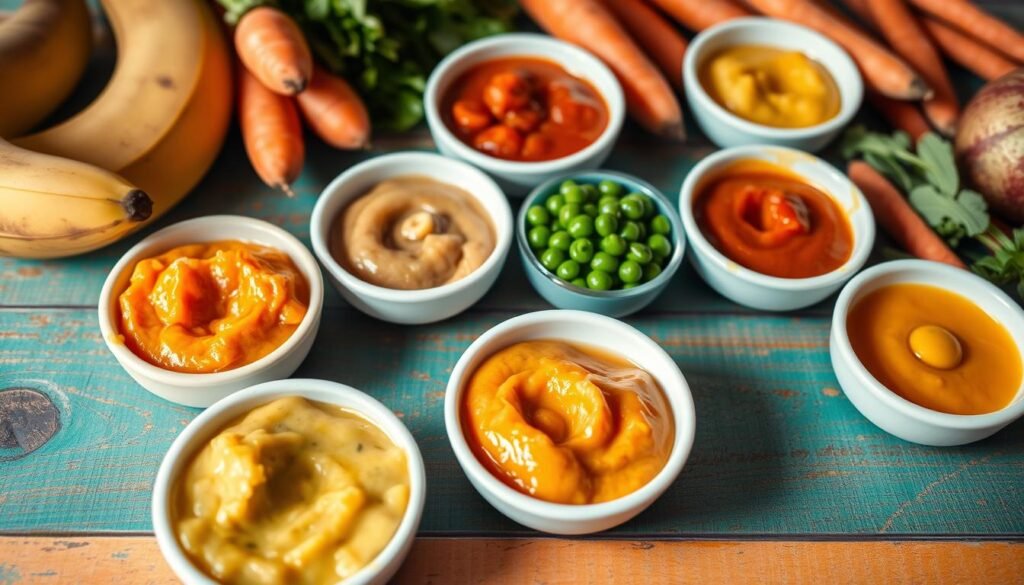
First Foods: Simple Fruit and Vegetable Purees
Starting your baby’s food journey with simple fruit and vegetable purees is a great idea. These baby recipes are not only healthy but also let you choose what goes into them. Here are some easy homemade baby purees that your baby will love.
Nourishing Fruit Purees
- Apple Puree: Peel, core, and cook apples until soft, then blend into a smooth consistency.
- Banana Puree: Mash ripe bananas with a fork or blend until creamy.
- Pear Puree: Peel, core, and cook pears until tender, then puree until smooth.
Veggie-Packed Blends
- Sweet Potato Puree: Bake or boil sweet potatoes until soft, then mash or blend into a creamy puree.
- Butternut Squash Puree: Roast or steam butternut squash, then puree until smooth.
- Carrot Puree: Boil or steam carrots until tender, then blend into a velvety puree.
Always introduce one new food at a time and watch for any signs of allergy. Keep your baby recipes in the fridge or freezer for easy access and longer shelf life.
| Fruit Puree | Vegetable Puree |
|---|---|
| Apple | Sweet Potato |
| Banana | Butternut Squash |
| Pear | Carrot |
“Homemade baby recipes are a wonderful way to nourish your little one and introduce them to a wide variety of flavors.”
Starting with these simple purees is a great way to help your baby develop healthy eating habits. Enjoy finding out what flavors and textures your baby loves most!
Baby Recipes for Different Age Groups
As your little one grows, their nutritional needs and food preferences change. Offering a variety of wholesome, stage-based baby meal ideas is key. This ensures your child gets the essential nutrients they need during this important time.
6-8 Months Meal Ideas
For the 6-8 month stage, focus on smooth, single-ingredient purees. These introduce your baby to fruits and vegetables. Try purees like sweet potato, banana, or butternut squash. You can also mix purees for more complex flavors, such as pear and spinach or apple and cinnamon.
9-12 Months Recipe Suggestions
At 9-12 months, your baby is ready for more textured foods. Soft, mashed dishes are great for self-feeding. Healthy recipes like lentil and veggie mash, quinoa and mango bites, or chicken and brown rice casserole are nutritious and tasty.
Toddler-Friendly Transitions
When your little one becomes a toddler, their appetite and tastes grow more adventurous. Offer finger foods like roasted sweet potato wedges, mini meatballs, or whole grain pasta with veggie-based sauces. These ideas encourage independence, texture exploration, and a positive food relationship.
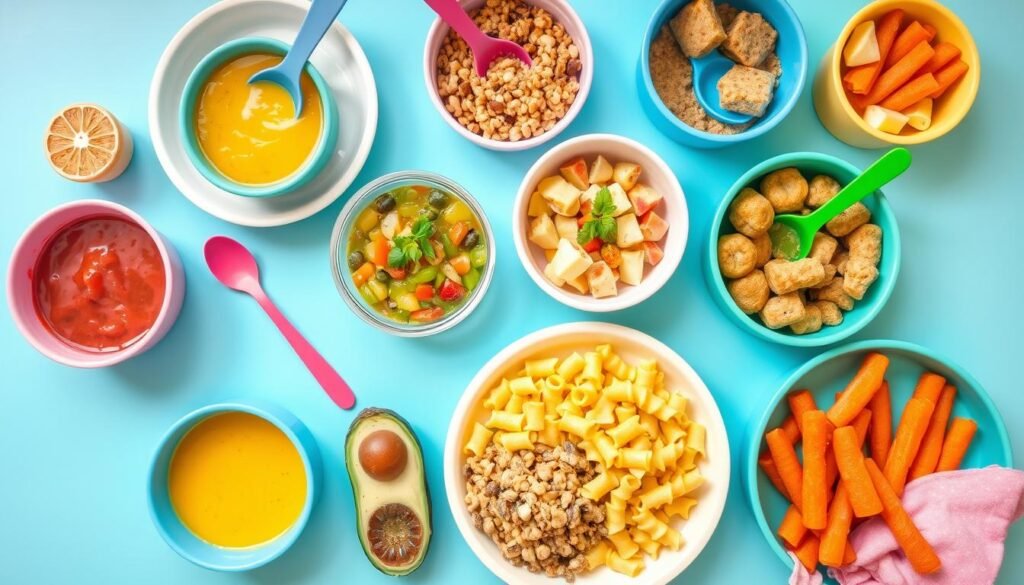
| Age Group | Meal Ideas | Nutritional Focus |
|---|---|---|
| 6-8 Months | Sweet potato puree Banana puree Pear and spinach puree | Smooth, single-ingredient purees Introduce new flavors |
| 9-12 Months | Lentil and veggie mash Quinoa and mango bites Chicken and brown rice casserole | Soft, mashed dishes Self-feeding exploration |
| Toddler | Roasted sweet potato wedges Mini meatballs Whole grain pasta with veggie-based sauce | Finger foods Texture exploration Positive food relationships |
By tailoring your baby’s meals to their age and needs, you ensure a nourishing journey from infancy to toddlerhood.
Introducing Protein-Rich Baby Foods
As your baby grows, they need protein for muscle and health. You can find protein in lean meats, fish, legumes, and plant-based foods. These foods are tasty and good for your baby.
Protein-Packed Purees
Start with simple purees like chicken, turkey, or fish. Blend them with breast milk or formula for a smooth texture. Add spices and herbs to make them tasty without being too strong.
Lentil and Bean Blends
Lentils and beans are great for plant-based protein. Mix cooked lentils or beans with veggies or fruits for a protein-rich meal. They’re good for many baby food recipes.
Tofu and Tempeh Purees
For plant-based options, try tofu or tempeh. These soy foods are full of protein. Start with small amounts to see how your baby likes them.
| Protein-Rich Ingredient | Nutritional Benefits | Recipe Suggestions |
|---|---|---|
| Chicken | High in protein, vitamins, and minerals | Pureed Chicken and Sweet Potato |
| Salmon | Excellent source of omega-3 fatty acids | Baked Salmon and Broccoli Puree |
| Lentils | Rich in fiber, folate, and iron | Lentil and Butternut Squash Blend |
| Tofu | Provides plant-based protein and calcium | Creamy Tofu and Mango Puree |
Adding protein-rich baby recipes to your baby’s diet helps them grow. Introduce new foods slowly and watch for any reactions. This ensures a healthy and enjoyable eating experience.
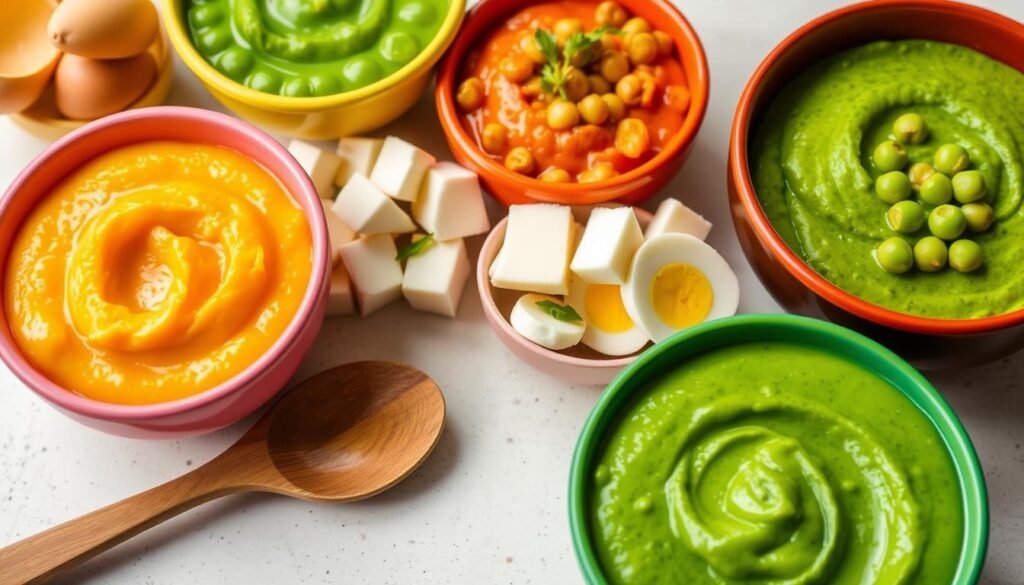
Creative Combinations for Adventurous Eaters
As your little one’s taste buds grow, it’s time to try new flavors. Mixing fruits, veggies, and grains can make exciting tastes and textures. These will surely delight even the pickiest eaters.
Fruit and Vegetable Blends
Be creative with fruit and veggie mixes. Try apples with cooked spinach or butternut squash with bananas. These combos burst with flavors that will excite your baby’s senses and encourage them to explore new tastes.
Grain-Based Mixtures
Adding whole grains to your baby’s meals boosts nutrition. Mix oatmeal, quinoa, or brown rice with avocado, prunes, or cinnamon-spiced pear. The earthy flavors of grains make a great base for adventurous pairings.
| Fruit and Vegetable Blend | Grain-Based Mixture |
|---|---|
| Mashed Sweet Potato with Applesauce | Quinoa Porridge with Roasted Beets |
| Pear and Spinach Puree | Brown Rice Cereal with Mashed Avocado |
| Roasted Butternut Squash and Mango | Oatmeal with Stewed Prunes and Cinnamon |
Start with simple flavors and gradually add new ones for adventurous meals. With patience and creativity, you can help your baby love healthy, homemade purees and meal ideas for life.
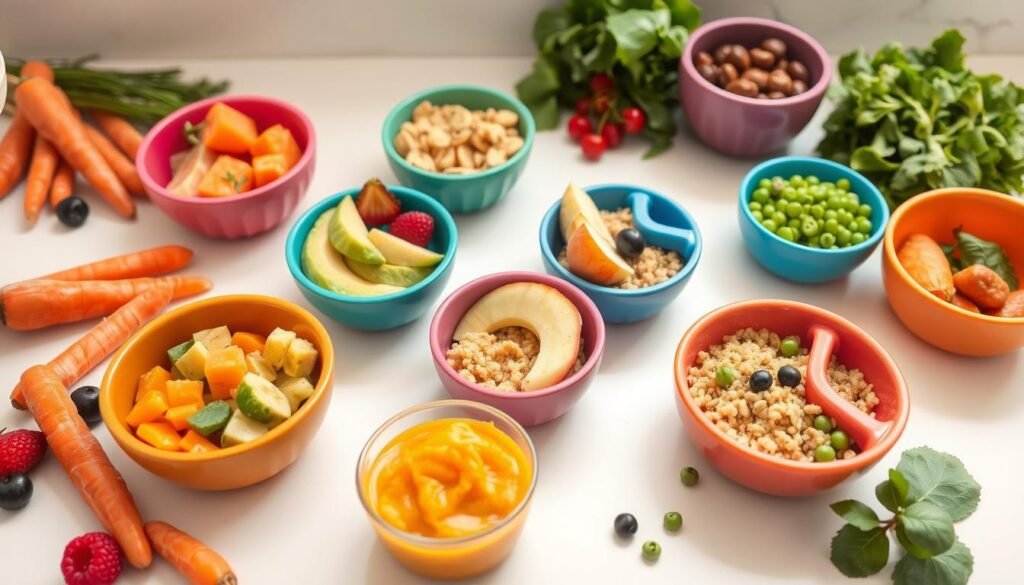
Quick and Easy Baby Food Preparation Methods
As a busy parent, I know how important it is to feed my baby healthy homemade food. But, finding time can be tough. Luckily, there are quick and easy ways to make tasty, nutritious meals for my baby.
Steaming is a favorite of mine. It keeps nutrients in fresh fruits and veggies and makes them smooth and creamy. This method is great because it’s easy and lets me do other things while the food cooks.
Roasting is another way I add flavor to baby food. It makes veggies and fruits taste sweeter and more complex. All I need to do is put them on a baking sheet and let the oven work its magic.
When I’m really short on time, I use no-cook options. I blend ripe avocado or banana into a creamy puree. These methods are quick and make sure my baby gets the nutrients they need, without taking up too much of my time.
| Preparation Method | Benefits | Time Required |
|---|---|---|
| Steaming | Preserves nutrients, creates a smooth texture | 15-20 minutes |
| Roasting | Enhances natural sweetness, adds depth of flavor | 25-30 minutes |
| No-Cook (Blending) | Quick and easy, retains maximum nutrition | 5-10 minutes |
Using these quick and easy methods, I can make sure my baby gets the best homemade food. It’s easy on me and good for them. It’s a win-win for both of us!
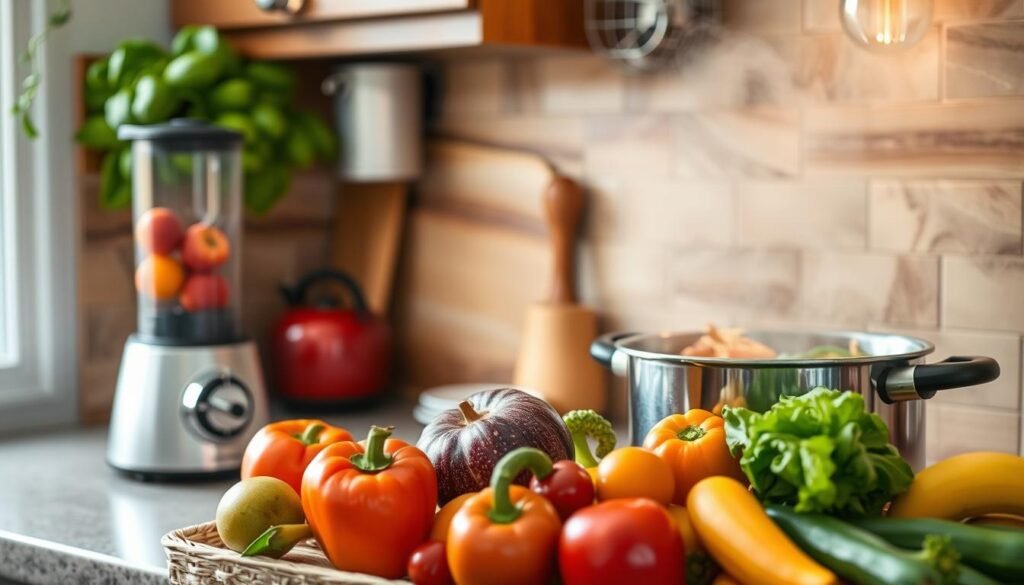
Seasonal Baby Recipes for Year-Round Nutrition
As a new parent, I’ve learned that a diverse and nutrient-rich diet is key for my baby’s growth. I’m excited to share some of my favorite seasonal baby recipes. They taste great and offer the best nutrition all year.
Spring and Summer Options
In the warmer months, I love adding fresh, local produce to my baby’s meals. Some of my top picks include:
- Creamy avocado and spinach puree
- Vibrant mango and sweet potato blend
- Refreshing strawberry and yogurt smoothie
These recipes are full of vitamins, minerals, and antioxidants. They support my baby’s health and immunity.
Fall and Winter Favorites
When the seasons change, I choose heartier, seasonal ingredients for my baby. Some of my favorites are:
- Roasted butternut squash and cinnamon puree
- Savory sweet potato and lentil mash
- Comforting apple and oatmeal porridge
These recipes are not only tasty and nutritious. They also keep my baby warm and cozy in the cold months.
By using seasonal, local ingredients, I ensure my baby gets a balanced diet all year. These recipes are easy to make and full of the nutrients my baby needs to grow strong.
Allergen-Free Baby Food Options
As a parent, making sure your baby is safe and happy is key. Starting them on solid foods can be tricky, especially with allergens. But, with the right info, you can make tasty and allergen-free baby foods just for them.
When making baby recipes, watch out for common allergens. These include cow’s milk, soy, wheat, eggs, peanuts, tree nuts, fish, and shellfish. These foods can cause problems for some babies, so it’s important to avoid them.
- Choose safe ingredients like rice, sweet potatoes, squash, and pureed fruits for healthy meals.
- Start with one new food at a time to see how your baby reacts and watch for any signs of allergies.
- Talk to your pediatrician to make a safe eating plan that fits your baby’s needs.
By focusing on allergen-free foods, you can make sure your baby’s meals are not only yummy but also safe. With a bit of planning and creativity, you can give your baby the best nutrition while exploring allergen-free baby foods with confidence.
Batch Cooking and Meal Planning for Baby
Preparing meals for your baby every day can feel overwhelming. But, with smart batch cooking and meal planning, you can save time. This way, your baby gets a balanced diet without hassle. Let’s look at how to make kitchen time more efficient and mealtime easier.
Weekly Prep Guidelines
Spending a few hours on the weekend for batch cooking can change your life. Here’s how to start:
- Choose 2-3 base recipes that can be changed for different meals, like purees or grain dishes.
- Make big batches of these staples, then freeze them in individual servings for easy reheating.
- Chop fresh fruits, veggies, and herbs ahead of time for quick meal prep during the week.
- Plan your meals for the week, using your batch-cooked items and adding fresh ingredients.
Storage Solutions
Keeping your baby food fresh and nutritious is crucial. Here are some tips:
- Freezer-friendly containers – Use BPA-free, airtight containers or ice cube trays for freezing.
- Labeling and dating – Label each container with what’s inside and when it was made to track freshness.
- Fridge vs. Freezer – Keep purees in the fridge for 3 days, and frozen items for 2-3 months.
- Thawing techniques – Thaw frozen portions in the fridge overnight or use a warm water bath for quick thawing.
Batch cooking and meal planning make feeding your baby easy and fun. You’ll spend less time cooking and more time with your baby.
Baby-Led Weaning Recipe Ideas
As a parent, I’ve found joy in baby-led weaning. It lets little ones try different finger foods early. This method boosts self-feeding, motor skills, and taste variety. Here are some top baby-led weaning recipes and baby meal ideas that are tasty and healthy.
Finger-Friendly Veggie Bites
Begin with veggie bites that are easy for babies to hold. Steam, roast, or sauté sweet potato, butternut squash, or zucchini until soft. Then, let your baby enjoy them with their fingers. These colorful, nutritious bites are great for starting self-feeding.
Whole Grain Puffs and Strips
Whole grains are key for your baby’s growth. Give soft, easy-to-grasp whole grain puffs or strips of cooked whole wheat bread or quinoa cakes. They offer a fun, textured eating experience.
| Baby-Led Weaning Recipe | Key Nutrients |
|---|---|
| Avocado and Banana Mash | Healthy fats, vitamins, and minerals |
| Chicken and Veggie Strips | Protein, iron, and a variety of vitamins |
| Lentil and Sweet Potato Fritters | Fiber, complex carbohydrates, and essential minerals |
Start the journey of baby-led weaning and let your baby discover tasty, healthy baby meal ideas. With creativity and patience, you can help your baby love eating well for life.
Time-Saving Tips for Busy Parents
As a busy parent, making healthy homemade baby food can seem hard. But, with smart hacks, you can make it easier. Here are some tips to help you save time and give your baby the best meals.
Multitask Like a Pro
Being efficient is crucial when you’re busy with parenting and household tasks. Try multitasking by prepping for different baby food recipes at once. Chop, puree, or steam various fruits and veggies while doing other things. This way, you can freeze a lot of healthy baby food.
Batch Cooking for the Win
Spending a few hours on the weekend to batch cook baby food can change your life. Make big batches of your baby’s favorite purees. Then, freeze them in portions for easy use all week. It saves time and makes sure your baby eats well.
Embrace Smart Kitchen Gadgets
Getting the right kitchen tools can really help with homemade baby food. Gadgets like blenders and food processors can quickly puree and mix. They make making baby food fast and easy.
Every minute saved in the kitchen means more time with your baby. By using these tips, you can give your baby healthy meals without losing your own sanity.
Troubleshooting Common Baby Food Challenges
Exploring the world of baby food can be both exciting and challenging. As parents, we face many unexpected hurdles when feeding our babies. Issues like texture problems and picky eating can seem overwhelming. But, with the right strategies and patience, you can help your baby enjoy a wide range of nutritious foods.
Texture Troubles
Babies have their own likes when it comes to food texture. Some might only like smooth foods, while others enjoy chunkier textures. Here are some tips to help with texture issues:
- Start by mixing smooth foods with finely minced or mashed ones.
- Give soft, cooked finger foods like steamed sweet potato or avocado slices to help them learn to feed themselves.
- Remember, it might take a few tries for your baby to get used to a new texture.
Picky Eating Solutions
Picky eating is a normal part of a baby’s growth. To help your baby try new foods, try these tips:
- Introduce a variety of baby meal ideas to expose them to different tastes and textures.
- Let your baby help with cooking to make them curious about food.
- Show your baby that you enjoy eating a variety of healthy foods.
- Keep trying – it can take up to 15 attempts for a child to accept a new food.
Every baby is different, so what works for one might not work for another. Stay patient, flexible, and open to new ideas. With time and consistency, your baby will develop a healthy and adventurous palate.
| Common Texture Issues | Solutions |
|---|---|
| Resistance to chunky textures | Gradually introduce new textures by mixing smooth purees with finely minced or mashed foods |
| Difficulty with self-feeding | Offer soft, cooked finger foods like steamed sweet potato or avocado slices |
| Slow to accept new textures | Be patient and persistent – it may take several tries before your baby accepts a new texture |
Conclusion
We’ve explored the world of baby recipes and homemade baby food together. I hope you now see the value in making your own meals for your baby. We’ve talked about the basics, from kitchen tools to safety tips.
Feeding your baby with homemade food is great for their health. It lets you introduce many flavors and textures. This helps them develop good eating habits from a young age.
Feeding your baby is a special and changing experience. It’s a chance to bond with your child and learn their tastes. With some creativity and the right knowledge, you can give your baby a strong start in life.
FAQ
What are the essential kitchen tools for preparing homemade baby food?
You’ll need a food processor or blender, a steamer or saucepan, and storage containers. Ice cube trays are also useful. These tools help you puree, cook, and store the food.
How do I properly store homemade baby food?
Store it in the fridge for 3-5 days or freeze for 2-3 months. Use airtight containers or ice cube trays. Thaw in the fridge before serving.
What are the different stages of baby food?
Baby food stages start with smooth purees for young ones. Then, move to thicker textures as they grow. Stages include: stage 1 (4-6 months), stage 2 (6-8 months), and stage 3 (8-12 months).
What are the key nutrients my baby needs?
Babies need protein, iron, zinc, vitamin A, vitamin C, and calcium. These nutrients support growth and health. Focus on these when making homemade meals.
How do I know if my baby is ready for solid foods?
Look for signs like sitting upright and showing interest in food. Around 6 months, babies are usually ready for solids.
What are some easy fruit and vegetable puree recipes to start with?
Start with sweet potatoes, butternut squash, bananas, avocados, and plain yogurt. They’re smooth and introduce new tastes.
What protein-rich foods can I incorporate into my baby’s diet?
Add meat, fish, eggs, beans, lentils, and tofu to their meals. Puree or finely mince these for easy digestion.
How can I prepare seasonal baby food recipes?
Use fresh, local produce for seasonal recipes. Try pea and mint in spring/summer, and apple and cinnamon or roasted root vegetables in fall/winter.
What are some tips for batch cooking and meal planning for my baby?
Batch cooking saves time. Prep ingredients ahead, freeze, and plan meals weekly. This keeps your baby’s meals nutritious and varied.
How can I address texture issues or picky eating with my baby?
Start with smooth foods and gradually add texture. Offer different flavors and let them self-feed. Be patient and consistent to help them explore new tastes.
Leave a Reply